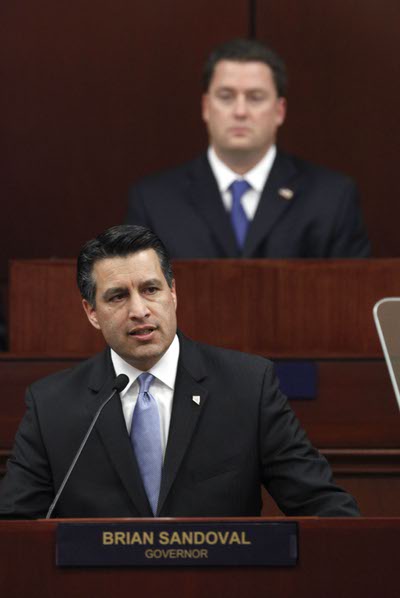Friday, Jan. 11, 2013 | 2 a.m.
CARSON CITY — Nevada’s hard fall from its peak seems to be over. The ugly years of shuttered businesses, massive layoffs and relentless cuts in education and government services are, for the most part, past.
But if this is the tenor of the state’s recovery, it will be a long and slow slog toward economic health, an improved education system and a government that doesn’t struggle to take care of the state’s neediest.
Gov. Brian Sandoval is set to deliver his State of the State address on Wednesday, the chief executive’s assessment and vision for the state delivered every two years, before the Legislature meets.
If Sandoval’s history holds, the address will be optimistic, emphasizing the progress Nevada has made since he was inaugurated in January 2011.
But in reality, job creation rates are sluggish. The state still leads the nation in unemployment. More Nevadans than ever are seeking food stamps from a strained government. More than a thousand people — children with autism or Down syndrome, adults with brain injuries, single mothers looking for child care — are on waiting lists for state services. And the state’s education system, marred by contentious labor disputes in Clark and Washoe county, is not performing.
Sandoval is confronted with a raft of challenges.
How does the job market recover, when one of the pillars of Nevada’s economy was based on construction workers building houses for other construction workers?
How can the education system, which struggled even when the state was flush with cash, be improved?
How does the state raise more money when it would mean going to businesses that continue to struggle to keep their doors open or Nevadans whose homes are severely underwater?
Sandoval has said he will support extending most of the $620 million in taxes passed in 2011 that would otherwise expire this year, in order to prevent cuts to education. But he will also seek to reduce some business taxes while finding more money for education.
Meanwhile, state employees have had to endure pay cuts for four years and the Clark County School District said it has cut $600 million over the past four years.
Sandoval will answer pressing question on how he will keep those promises — raising education funding while cutting taxes and keeping government spending cuts to a minimum — when he releases his budget the morning of the State of the State address.
As Sandoval enters his third year in office, here is a sobering reminder of where Nevada stands on the economy, education and it’s overall government.
The Economy
The Great Recession, according to state economists, started in December of 2007 and ended in June 2009. That was the burst of Nevada’s economic heyday. And don’t expect to get back there anytime soon.
“We’re in recovery, but we’re not out of the hospital,” said Stephen P. A. Brown, director of the Center for Business and Economic Research at UNLV.
Brown said that the recovery is slow, and it will be long, hampered by a construction sector that is still 50,000 jobs below its peak and a fragile housing market, where many properties are owned by banks or homeowners who aren’t making payments.
“We’re essentially overbuilt,” Brown said. And it’s not only in the residential market.
The Strip casinos and commercial development were overbuilt too, in part fueled by easy lending that allowed homeowners to take out second mortgages on their homes to finance vacations to Las Vegas.
Jeremy Aguero, principal of financial firm Applied Analysis, said that we need to stop comparing the state today to the peak years in 2006 and 2007,
“Employment is growing, the economy is showing some signs of economic diversification. Incomes are rising,” Aguero said. “I don’t think you could ask for a whole lot more. Are we good? no. Are we better? Yes.”
Sandoval has made economic development a priority for Nevada. But so far tax incentives have been granted for 2,900 jobs, according to records provided to the Las Vegas Sun.
In a state where 147,000 jobless Nevadans are still claiming unemployment insurance, and thousands more are underemployed or have given up looking for work, that’s just a drop in the bucket.
Since the number of Nevada jobs bottomed out at 1,109,300 in September 2010, the state has gained just 38,900 jobs, according to employer surveys.
Brown said Sandoval faces difficult decisions about raising taxes, which could hurt consumer spending and businesses, or cutting government services and education.
He noted that states with a more educated workforce have recovered more quickly from the recession. Nevada is not one of those states.
Education
If there was one vivid news fact last year on education, it was this: Nevada had the lowest graduation rate of any state in the U.S.
It was a reminder of what many education experts on both ends of the political spectrum say - that our state’s education system is not performing well.
The poor rankings come amid contentious labor negotiations in both Southern and Northern Nevada school districts. Clark and Washoe school districts lost their bids to prevent teachers from receiving pay increases. The Clark County School District had to eliminate 1,000 teaching positions as a result.
Nevada Department of Education Superintendent James Guthrie, appointed by Sandoval, said the governor will propose a funding increase of about 2 percent.
“Is that enough? I don’t know,” he said. “But it’s in the right direction, that’s for sure.”
Sandoval will propose new resources and programs, committing new revenue generated in the economic recovery to education.
“He’s really dug deep into the state treasury,” Guthrie said.
Sandoval also has a new Board of Education, which is more accountable to him. And a new council of business leaders, from a variety of sectors, will be formed to advise the state. That makes Guthrie hopeful about the future of education in Nevada.
Clark County Superintendent Dwight Jones said “progress is being made.”
He pointed to turnaround schools, where principals are given more control over personnel along with additional accountability measures, and improvements in the state’s graduation rate from the previous year.
“But the conversation both internally, as well as externally, is, is it enough?” Jones said.
Part of the reason some schools are struggling is because of money, he added.
Class sizes in Clark County, for example, went up roughly two to three students per class on average.
When he became the Clark County superintendent two years ago, Jones made a point not to “just ask for more money,” he said. He wanted to evaluate how money was being spent. Now he’s ready to start asking for additional funding.
“The system is making some progress doing more with less,” he said. “But we’re getting to that pivotal place where it’s difficult to sustain that. Less is almost becoming less.”
He said increased prices of gas and electricity add between $30 million and $40 million in costs each year. Additionally, the district faces another round of negotiations with its labor unions.
More students in poverty are entering the school system, and more are coming in speaking English as a second language.
Asked how much additional money the district would need, Jones said, “I don’t know for sure what would be adequate.”
General government
In the summer of 2011, after the last Legislature adjourned and lawmakers went home, the state sent out chilling notices to parents of children with disabilities receiving services through the state. Their children would get fewer services or not be able to get them at all, because of a lack of money.
Cutting services for children with autism and Down syndrome would, it seems, be a last resort for the state. But often times, cuts to programs used by the poor, disabled and mentally ill are unnoticed or ignored by the media and public at large. And it also demonstrates just how fragile Nevada’s social safety net is.
Sandoval’s budget puts more money into some programs, including the state’s Early Intervention Program, which serves newborns to three-year-old.
And part of his commitment to extend taxes was to preserve the “essential services” in state government.
But in health and human services, more than a thousand of people are on wait lists for things like child care, mental health services and help to be able to stay in their homes.
More broadly, other areas of state government are also looking for more money. Agencies asked for $419 million over the cap Sandoval put on spending requests. Some of those “items for special consideration” are for items that agencies would like to have, such as more money to spend on economic development, to incubate businesses. Another request was for a new, more reliable computer system for law enforcement to run background checks during police stops.
But other spending requests that came in over the cap are for what department heads termed “essential.”
In a speech billed as the “progressive State of the State,” former Sen. Sheila Leslie called them “items Nevada really needs but can’t afford.”



Join the Discussion:
Check this out for a full explanation of our conversion to the LiveFyre commenting system and instructions on how to sign up for an account.
Full comments policy